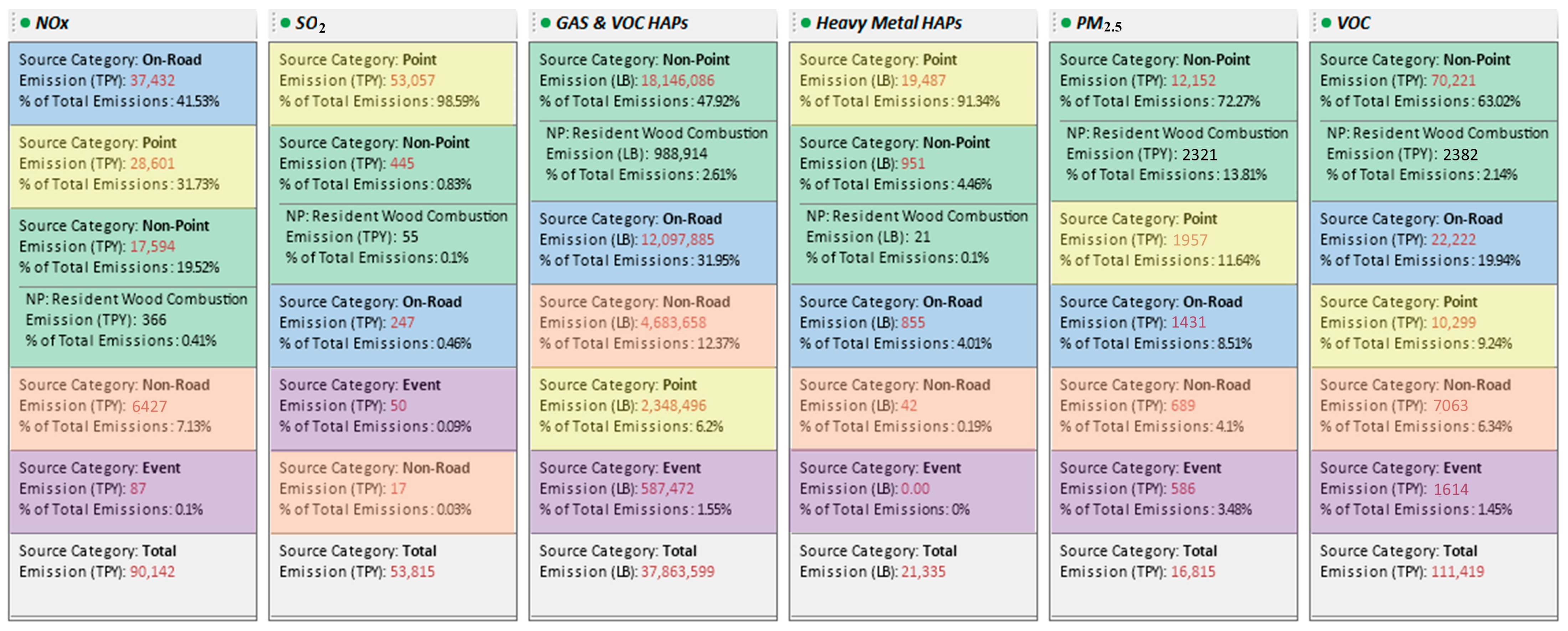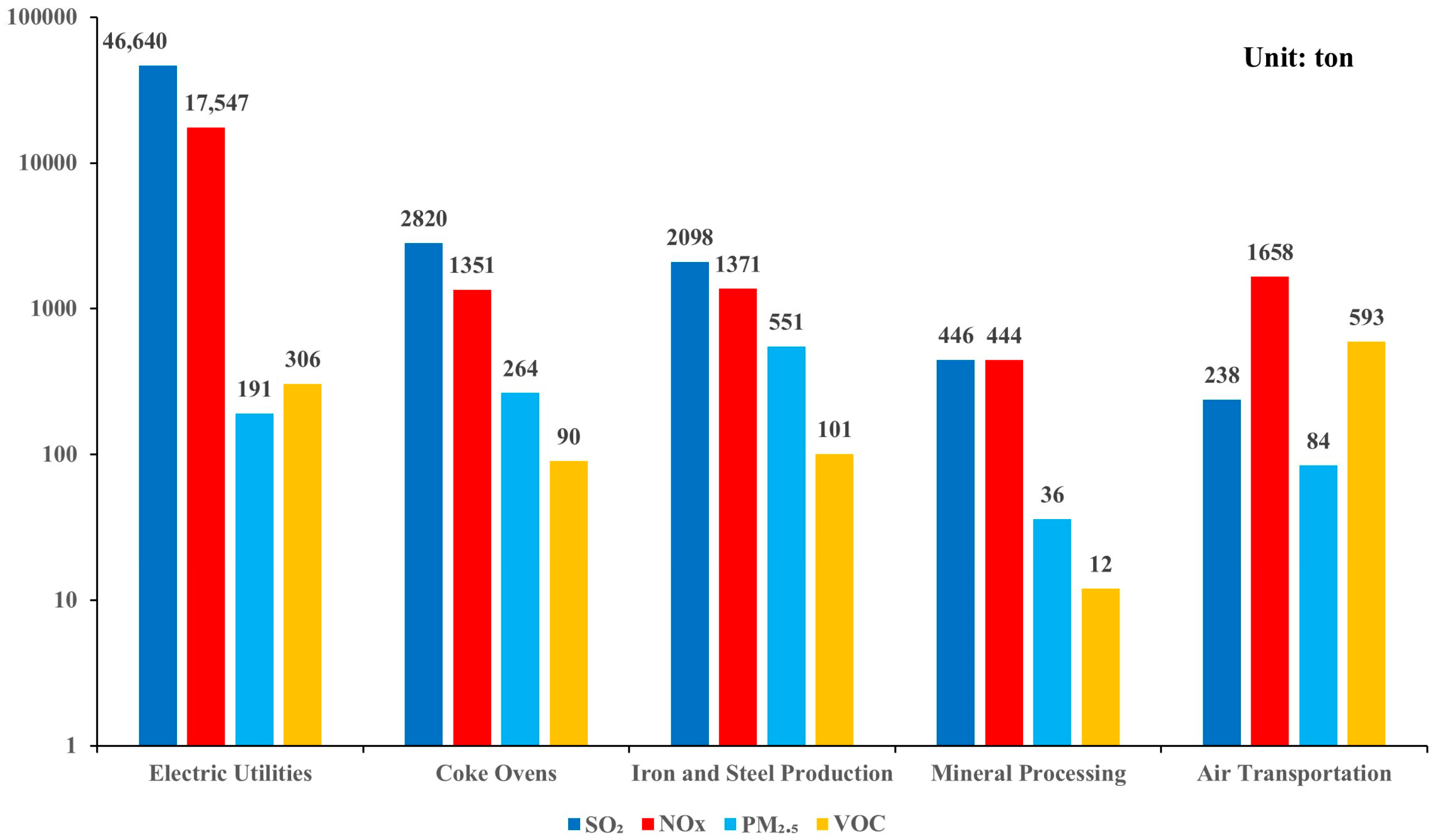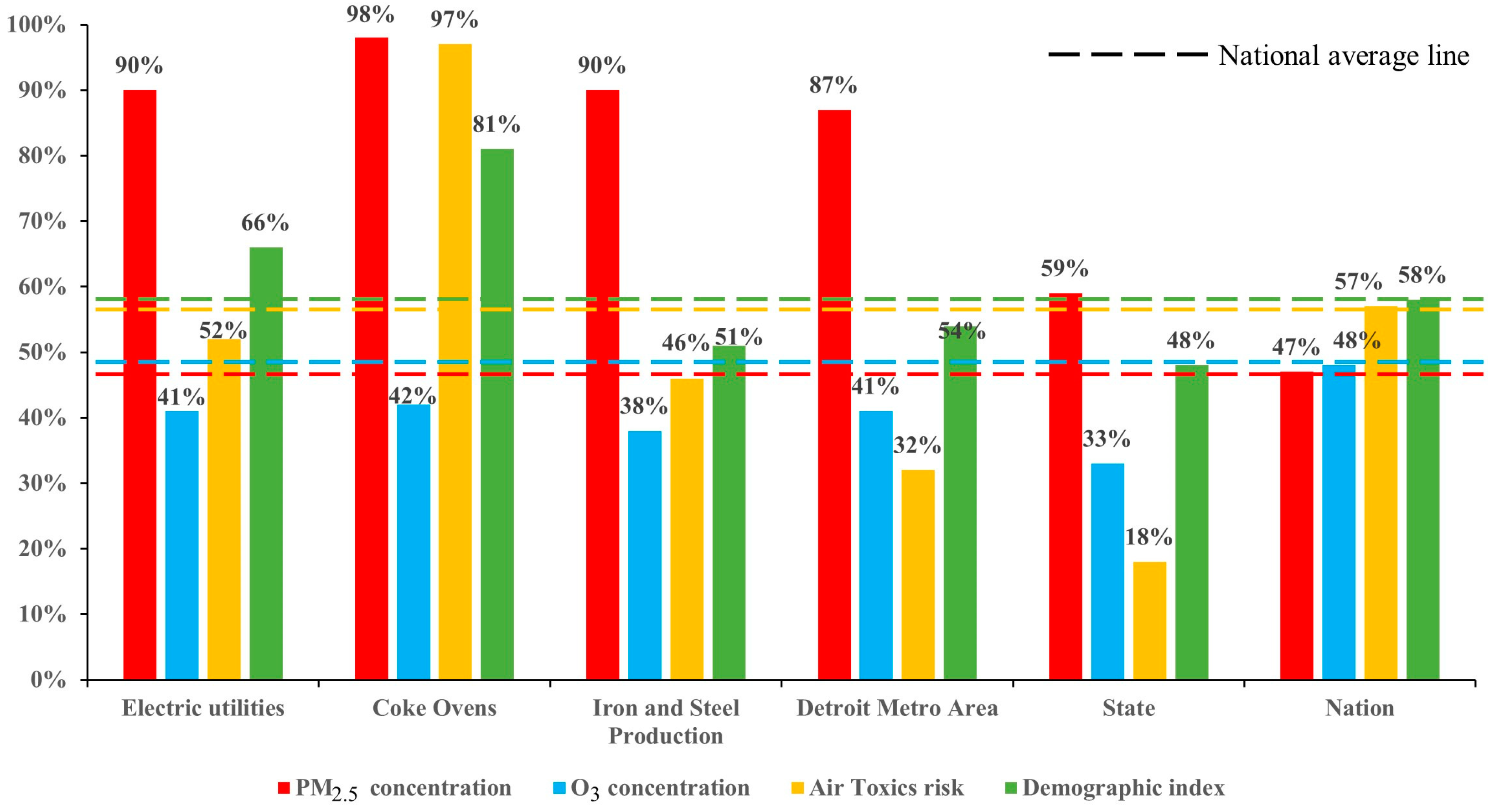A Multi-Pollutant Air Quality Analysis with Environmental Justice Considerations: Case Study for Detroit
Abstract
1. Introduction
2. Data and Methods
2.1. Data
2.1.1. Emissions Data
2.1.2. O3 and PM2.5 Modeled Concentration Data
2.1.3. Air Toxics Cancer Risk Data
2.1.4. EJ/Demographic Data
2.1.5. Other Data
2.2. Methods
2.2.1. Multi-Pollutant and EJ Issues National/Regional Mapping and Screening
2.2.2. Proximity Analysis
3. Case Study
3.1. National Level Analysis of Multi-Pollutant and EJ (Continental U.S.)
3.2. Air Quality, Air Toxics, and EJ Indicators over Detroit Metro Area
3.3. Emissions Data over Detroit Metro Area
3.4. Proximity Analysis of POIs over Detroit Metro Area
4. Conclusions
Supplementary Materials
Author Contributions
Funding
Institutional Review Board Statement
Informed Consent Statement
Data Availability Statement
Acknowledgments
Conflicts of Interest
References
- National Research Council. Air Quality Management in the United States; National Academies Press: Washington, DC, USA, 2004. [Google Scholar]
- Luben, T.J.; Buckley, B.J.; Patel, M.M.; Stevens, T.; Coffman, E.; Rappazzo, K.M.; Owens, E.O.; Hines, E.P.; Moore, D.; Painter, K.; et al. A Cross-Disciplinary Evaluation of Evidence for Multipollutant Effects on Cardiovascular Disease. Environ. Res. 2018, 161, 144–152. [Google Scholar] [CrossRef] [PubMed]
- Sakti, A.D.; Anggraini, T.S.; Ihsan, K.T.N.; Misra, P.; Trang, N.T.Q.; Pradhan, B.; Wenten, I.G.; Hadi, P.O.; Wikantika, K. Multi-Air Pollution Risk Assessment in Southeast Asia Region Using Integrated Remote Sensing and Socio-Economic Data Products. Sci. Total Environ. 2023, 854, 158825. [Google Scholar] [CrossRef] [PubMed]
- Jonidi Jafari, A.; Charkhloo, E.; Pasalari, H. Urban Air Pollution Control Policies and Strategies: A Systematic Review. J. Environ. Health Sci. Eng. 2021, 19, 1911–1940. [Google Scholar] [CrossRef] [PubMed]
- Macpherson, A.J.; Simon, H.; Langdon, R.; Misenheimer, D. A Mixed Integer Programming Model for National Ambient Air Quality Standards (NAAQS) Attainment Strategy Analysis. Environ. Model. Softw. 2017, 91, 13–27. [Google Scholar] [CrossRef]
- Wang, Z.; Zhao, H.; Xu, H.; Li, J.; Ma, T.; Zhang, L.; Feng, Y.; Shi, G. Strategies for the Coordinated Control of Particulate Matter and Carbon Dioxide under Multiple Combined Pollution Conditions. Sci. Total Environ. 2023, 899, 165679. [Google Scholar] [CrossRef]
- Tan, X.; Han, L.; Zhang, X.; Zhou, W.; Li, W.; Qian, Y. A Review of Current Air Quality Indexes and Improvements under the Multi-Contaminant Air Pollution Exposure. J. Environ. Manag. 2021, 279, 111681. [Google Scholar] [CrossRef] [PubMed]
- Tavallali, P.; Gharibi, H.; Singhal, M.; Schweizer, D.; Cisneros, R. A Multi-Pollutant Model: A Method Suitable for Studying Complex Relationships in Environmental Epidemiology. Air Qual. Atmos. Health 2020, 13, 645–657. [Google Scholar] [CrossRef]
- Yu, L.; Liu, W.; Wang, X.; Ye, Z.; Tan, Q.; Qiu, W.; Nie, X.; Li, M.; Wang, B.; Chen, W. A Review of Practical Statistical Methods Used in Epidemiological Studies to Estimate the Health Effects of Multi-Pollutant Mixture. Environ. Pollut. 2022, 306, 119356. [Google Scholar] [CrossRef] [PubMed]
- U.S. EPA. U.S. EPA—South Carolina Collaboration to Develop a Multi-Pollutant, Risk-Based Air Quality Management Strategy for the Upstate South Carolina Region. 2016. Available online: https://www.epa.gov/sites/default/files/2016-05/documents/usepa-south_carolina_final_report_may_26_16_2.pdf (accessed on 2 June 2024).
- Hidy, G.M.; Pennell, W.T. Multipollutant Air Quality Management. J. Air Waste Manag. Assoc. 2010, 60, 645–674. [Google Scholar] [CrossRef]
- Fann, N.; Roman, H.A.; Fulcher, C.M.; Gentile, M.A.; Hubbell, B.J.; Wesson, K.; Levy, J.I. Maximizing Health Benefits and Minimizing Inequality: Incorporating Local-Scale Data in the Design and Evaluation of Air Quality Policies. Risk Anal. 2011, 31, 908–922. [Google Scholar] [CrossRef]
- Bay Area Air Quality Management District (BAAQMD). Clean Air Plan 2017. 2017. Available online: https://www.baaqmd.gov/~/media/files/planning-and-research/plans/2017-clean-air-plan/attachment-a_-proposed-final-cap-vol-1-pdf (accessed on 2 June 2024).
- Louisville Metropolitan Air Pollution Control District (APCD). Multipollutant Stakeholder Group Final Report August 2020. 2020. Available online: https://louisvilleky.gov/air-pollution-control-district/document/finalmpsgreportpdf (accessed on 2 June 2024).
- Huang, J.; Zhu, Y.; Kelly, J.T.; Jang, C.; Wang, S.; Xing, J.; Chiang, P.-C.; Fan, S.; Zhao, X.; Yu, L. Large-Scale Optimization of Multi-Pollutant Control Strategies in the Pearl River Delta Region of China Using a Genetic Algorithm in Machine Learning. Sci. Total Environ. 2020, 722, 137701. [Google Scholar] [CrossRef]
- Cantuaria, M.L.; Brandt, J.; Lofstrom, P.; Blanes-Vidal, V. Public Perception of Rural Environmental Quality: Moving towards a Multi-Pollutant Approach. Atmos. Environ. 2017, 170, 234–244. [Google Scholar] [CrossRef]
- Sofia, D.; Gioiella, F.; Lotrecchiano, N.; Giuliano, A. Mitigation Strategies for Reducing Air Pollution. Environ. Sci. Pollut. Res. 2020, 27, 19226–19235. [Google Scholar] [CrossRef]
- Illgner, T.; Lad, N. Data to Improve Air Quality Environmental Justice Outcomes in South Chicago. Front. Public Health 2022, 10, 977948. [Google Scholar] [CrossRef]
- Zalzal, J.; Hatzopoulou, M. Fifteen Years of Community Exposure to Heavy-Duty Emissions: Capturing Disparities over Space and Time. Environ. Sci. Technol. 2022, 56, 16621–16632. [Google Scholar] [CrossRef]
- Su, J.G.; Morello-Frosch, R.; Jesdale, B.M.; Kyle, A.D.; Shamasunder, B.; Jerrett, M. An Index for Assessing Demographic Inequalities in Cumulative Environmental Hazards with Application to Los Angeles, California. Environ. Sci. Technol. 2009, 43, 7626–7634. [Google Scholar] [CrossRef]
- Su, J.G.; Jerrett, M.; Morello-Frosch, R.; Jesdale, B.M.; Kyle, A.D. Inequalities in Cumulative Environmental Burdens among Three Urbanized Counties in California. Environ. Int. 2012, 40, 79–87. [Google Scholar] [CrossRef]
- Wen, Y.; Zhang, S.; Wang, Y.; Yang, J.; He, L.; Wu, Y.; Hao, J. Dynamic Traffic Data in Machine-Learning Air Quality Mapping Improves Environmental Justice Assessment. Environ. Sci. Technol. 2024, 58, 3118–3128. [Google Scholar] [CrossRef]
- Zhao, J.; Gladson, L.; Cromar, K. A Novel Environmental Justice Indicator for Managing Local Air Pollution. Int. J. Environ. Res. Public Health 2018, 15, 1260. [Google Scholar] [CrossRef] [PubMed]
- Scheffe, R.; Hubbell, B.; Fox, T.; Rao, V.; Pennell, W. The Rationale for a Multipollutant, Multimedia Air Quality Management Framework; AWMA: Pittsburgh, PA, USA, 2007; pp. 14–20. [Google Scholar]
- U.S. EPA. The Multi-Pollutant Report Technical Concept and Examples. 2008. Available online: https://nepis.epa.gov/Exe/ZyPDF.cgi/P100ZZDJ.PDF?Dockey=P100ZZDJ.PDF (accessed on 2 June 2024).
- Greenberg, M.R. Ports and Environmental Justice in the United States: An Exploratory Statistical Analysis. Risk Anal. 2021, 41, 2112–2126. [Google Scholar] [CrossRef] [PubMed]
- U.S. EPA. EJScreen: Environmental Justice Screening and Mapping Tool. Available online: https://www.epa.gov/ejscreen (accessed on 2 June 2024).
- Mathieu, M.E.; Gray, J.; Richmond-Bryant, J. Spatial Associations of Long-Term Exposure to Diesel Particulate Matter with Seasonal and Annual Mortality Due to COVID-19 in the Contiguous United States. BMC Public Health 2023, 23, 1–15. [Google Scholar] [CrossRef] [PubMed]
- U.S. EPA. Air Toxics Screening Assessment. Available online: https://www.epa.gov/AirToxScreen (accessed on 2 June 2024).
- Wesson, K.; Fann, N.; Morris, M.; Fox, T.; Hubbell, B. A Multi–Pollutant, Risk–Based Approach to Air Quality Management: Case Study for Detroit. Atmos. Pollut. Res. 2010, 1, 296–304. [Google Scholar] [CrossRef]
- U.S. EPA. 2017 National Emissions Inventory: January 2021 Updated Release, Technical Support Document. 2021. Available online: https://www.epa.gov/sites/default/files/2021-02/documents/nei2017_tsd_full_jan2021.pdf (accessed on 2 June 2024).
- U.S. EPA. Bayesian Space-Time Downscaling Fusion Model (Downscaler)—Derived Estimates of Air Quality for 2019. 2019. Available online: https://ofmpub.epa.gov/rsig/rsigserver?data/FAQSD/docs/2019_DS_Annual_Report.pdf (accessed on 2 June 2024).
- Berrocal, V.J.; Gelfand, A.E.; Holland, D.M. Space-Time Data Fusion Under Error in Computer Model Output: An Application to Modeling Air Quality. Biometrics 2012, 68, 837–848. [Google Scholar] [CrossRef] [PubMed]
- U.S. EPA. Technical Support Document EPA’s Air Toxics Screening Assessment 2018 AirToxScreen TSD. 2018. Available online: https://www.epa.gov/sites/default/files/2013-09/documents/cancer_guidelines_final_3-25-05.pdf (accessed on 2 June 2024).
- U.S. EPA. EJScreen Technical Documentation for Version 2.2. 2023. Available online: https://www.epa.gov/system/files/documents/2023-06/ejscreen-tech-doc-version-2-2.pdf (accessed on 2 June 2024).
- U.S. EPA. Air Quality Design Values. Available online: https://www.epa.gov/air-trends/air-quality-design-values (accessed on 2 June 2024).
- Mohai, P.; Saha, R. Which Came First, People or Pollution? Assessing the Disparate Siting and Post-Siting Demographic Change Hypotheses of Environmental Injustice. Environ. Res. Lett. 2015, 10, 115008. [Google Scholar] [CrossRef]
- Mohai, P.; Saha, R. Racial Inequality in the Distribution of Hazardous Waste: A National-Level Reassessment. Soc. Probl. 2007, 54, 343–370. [Google Scholar] [CrossRef]
- Fann, N.; Wesson, K.; Hubbell, B. Characterizing the Confluence of Air Pollution Risks in the United States. Air Qual. Atmos. Health 2016, 9, 293–301. [Google Scholar] [CrossRef]
- U.S. EPA. National Air Quality: Status and Trends of Key Air Pollutants. Available online: https://www.epa.gov/air-trends (accessed on 2 June 2024).
- Ash, M.; Boyce, J.K.; Chang, G.; Scharber, H. Is Environmental Justice Good for White Folks? Industrial Air Toxics Exposure in Urban America. Soc. Sci. Quart. 2013, 94, 616–636. [Google Scholar] [CrossRef]
- Collins, T.W.; Nadybal, S.M.; Grineski, S.E. A Comparative Approach for Environmental Justice Analysis: Explaining Divergent Societal Distributions of Particulate Matter and Ozone Pollution across U.S. Neighborhoods. Ann. Am. Assoc. Geogr. 2022, 112, 522–541. [Google Scholar] [CrossRef]
- Colmer, J.; Hardman, I.; Shimshack, J.; Voorheis, J. Disparities in PM2.5 Air Pollution in the United States. Science 2020, 369, 575–578. [Google Scholar] [CrossRef]
- Driver, A.; Mehdizadeh, C.; Bara-Garcia, S.; Bodenreider, C.; Lewis, J.; Wilson, S. Utilization of the Maryland Environmental Justice Screening Tool: A Bladensburg, Maryland Case Study. Int. J. Environ. Res. Public Health 2019, 16, 348. [Google Scholar] [CrossRef]
- McFarlin, E.; Bargagli-Stoffi, F.J.; Castro, E.; Schwartz, J.; Dominici, F.; Amini, H. Air Quality Disparities Mapper: An Open-Source Web Application for Environmental Justice. Environ. Model. Softw. 2024, 172, 105881. [Google Scholar] [CrossRef]
- Zirogiannis, N.; Byrne, A.; Hollingsworth, A.J.; Konisky, D.M. Polluting under the Radar: Emissions, Inequality, and Concrete Batch Plants in Houston. Environ. Sci. Technol. 2023, 57, 11410–11419. [Google Scholar] [CrossRef] [PubMed]
- Cheng, J.; Tong, D.; Zhang, Q.; Liu, Y.; Lei, Y.; Yan, G.; Yan, L.; Yu, S.; Cui, R.Y.; Clarke, L.; et al. Pathways of China’s PM2.5 Air Quality 2015–2060 in the Context of Carbon Neutrality. Natl. Sci. Rev. 2021, 8, nwab078. [Google Scholar] [CrossRef] [PubMed]
- Cheng, J.; Tong, D.; Liu, Y.; Geng, G.; Davis, S.J.; He, K.; Zhang, Q. A Synergistic Approach to Air Pollution Control and Carbon Neutrality in China Can Avoid Millions of Premature Deaths Annually by 2060. One Earth 2023, 6, 978–989. [Google Scholar] [CrossRef]
- Zhou, W.; Chen, C.; Lei, L.; Fu, P.; Sun, Y. Temporal Variations and Spatial Distributions of Gaseous and Particulate Air Pollutants and Their Health Risks during 2015–2019 in China. Environ. Pollut. 2021, 272, 116031. [Google Scholar] [CrossRef] [PubMed]
- Xing, J.; Zheng, S.; Ding, D.; Kelly, J.T.; Wang, S.; Li, S.; Qin, T.; Ma, M.; Dong, Z.; Jang, C.; et al. Deep Learning for Prediction of the Air Quality Response to Emission Changes. Environ. Sci. Technol. 2020, 54, 8589–8600. [Google Scholar] [CrossRef] [PubMed]
- Martenies, S.; Milando, C.; Williams, G.; Batterman, S. Disease and Health Inequalities Attributable to Air Pollutant Exposure in Detroit, Michigan. Int. J. Environ. Res. Public Health 2017, 14, 1243. [Google Scholar] [CrossRef] [PubMed]
- Schulz, A.J.; Mentz, G.B.; Sampson, N.; Ward, M.; Anderson, R.; De Majo, R.; Israel, B.A.; Lewis, T.C.; Wilkins, D. Race and the Distribution of Social and Physical Environmental Risk: A Case Example from the Detroit Metropolitan Area. Du Bois Rev. Soc. Sci. Res. Race 2016, 13, 285–304. [Google Scholar] [CrossRef]
- Keswani, A.; Akselrod, H.; Anenberg, S.C. Health and Clinical Impacts of Air Pollution and Linkages with Climate Change. NEJM Evid. 2022, 1, EVIDra2200068. [Google Scholar] [CrossRef]
- Tran, H.M.; Tsai, F.-J.; Lee, Y.-L.; Chang, J.-H.; Chang, L.-T.; Chang, T.-Y.; Chung, K.F.; Kuo, H.-P.; Lee, K.-Y.; Chuang, K.-J.; et al. The Impact of Air Pollution on Respiratory Diseases in an Era of Climate Change: A Review of the Current Evidence. Sci. Total Environ. 2023, 898, 166340. [Google Scholar] [CrossRef]
- Smirnova, N.; Shaver, A.C.; Mehta, A.J.; Philipsborn, R.; Scovronick, N. Climate Change, Air Quality, and Pulmonary Health Disparities. Clin. Chest Med. 2023, 44, 489–499. [Google Scholar] [CrossRef] [PubMed]
- Forster, P.; Ramaswamy, V.; Artaxo, P.; Berntsen, T.; Betts, R.; Fahey, D.W.; Haywood, J.; Lean, J.; Lowe, D.C.; Myhre, G.; et al. Changes in Atmospheric Constituents and in Radiative Forcing. In Climate Change 2007: The Physical Science Basis; Contribution of Working Group I to the Fourth Assessment Report of the Intergovernmental Panel on Climate Change; Solomon, S., Qin, D., Manning, M., Chen, Z., Marquis, M., Averyt, K.B., Tignor, M., Miller, H.L., Eds.; Cambridge University Press: Cambridge, UK; New York, NY, USA, 2007; p. 212. [Google Scholar]









| Type | Source | Period |
|---|---|---|
| County-level emissions of CAPs, HAPs and GHGs | OAQPS public website a | 2017 |
| Facility-level emissions of CAPs, HAPs and GHGs | OAQPS public website a | 2017 |
| O3, PM2.5 concentration data at census tract-level | OAQPS b | 2019 |
| Air toxics cancer risk data at census tract-level | AirToxScreen c | 2018 |
| O3 and PM2.5 design values at county-level | U.S. EPA public website d | 2019 |
| O3 and PM2.5 monitoring data (annual) at site-level | SMAT-CE e | 2002 to 2020 |
| Air toxics monitoring data at site-level | OAQPS public website f | 2003 to 2020 |
| EJ/Demographic indicators from EJScreen | EJScreen g | 2021 |
| CEJST disadvantaged areas at census-tract level | CEJST h | 2022 |
| Pollutants | 2008 | 2011 | 2014 | 2017 | 2020 |
|---|---|---|---|---|---|
| Nitrogen Oxides | 88,746 | 62,425 | 51,582 | 34,730 | 20,407 |
| Primary PM2.5 | 8409 | 5180 | 5294 | 5483 | 6070 |
| Volatile Organic Compounds | 64,152 | 44,850 | 43,753 | 40,304 | 32,600 |
| Sulfur Dioxide | 55,662 | 43,272 | 34,198 | 15,952 | 6199 |
Disclaimer/Publisher’s Note: The statements, opinions and data contained in all publications are solely those of the individual author(s) and contributor(s) and not of MDPI and/or the editor(s). MDPI and/or the editor(s) disclaim responsibility for any injury to people or property resulting from any ideas, methods, instructions or products referred to in the content. |
© 2024 by the authors. Licensee MDPI, Basel, Switzerland. This article is an open access article distributed under the terms and conditions of the Creative Commons Attribution (CC BY) license (https://creativecommons.org/licenses/by/4.0/).
Share and Cite
Yuan, H.; Jang, J.-C.; Long, S.; Zhu, Y.; Wang, S.; Xing, J.; Zhao, B. A Multi-Pollutant Air Quality Analysis with Environmental Justice Considerations: Case Study for Detroit. Sustainability 2024, 16, 6931. https://doi.org/10.3390/su16166931
Yuan H, Jang J-C, Long S, Zhu Y, Wang S, Xing J, Zhao B. A Multi-Pollutant Air Quality Analysis with Environmental Justice Considerations: Case Study for Detroit. Sustainability. 2024; 16(16):6931. https://doi.org/10.3390/su16166931
Chicago/Turabian StyleYuan, Hui, Ji-Cheng Jang, Shicheng Long, Yun Zhu, Shuxiao Wang, Jia Xing, and Bin Zhao. 2024. "A Multi-Pollutant Air Quality Analysis with Environmental Justice Considerations: Case Study for Detroit" Sustainability 16, no. 16: 6931. https://doi.org/10.3390/su16166931
APA StyleYuan, H., Jang, J.-C., Long, S., Zhu, Y., Wang, S., Xing, J., & Zhao, B. (2024). A Multi-Pollutant Air Quality Analysis with Environmental Justice Considerations: Case Study for Detroit. Sustainability, 16(16), 6931. https://doi.org/10.3390/su16166931









